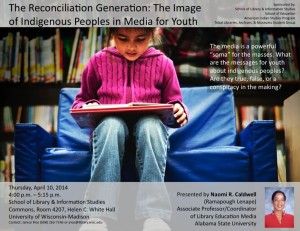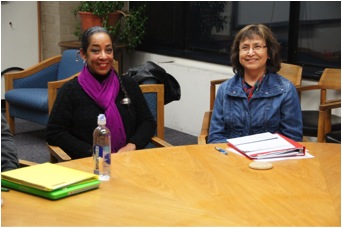This week, our class was visited by Naomi Caldwell, who spoke about her experiences living in New Zealand and researching the image of indigenous peoples, particularly as these two relate to children and youth. Some members of our class were fortunate enough to have the opportunity to attend the lecture she gave beforehand.
A recurring theme throughout readings and discussions this week was one of authenticity, not just of content but of voice as well. As librarians, it is our duty to encourage the inclusion of works by Indigenous authors, not just books containing Indigenous stories or ideas.
 One of the things Dr. Caldwell talked at length about in her lecture and during the Q&A session, was a children’s picture book, called Swim, which retold a traditional Maori story. This particular version of the story changed the ending from the original tragic story to a happy ending. There was criticism expressed too that the characters depicted in the illustrations do not look like indigenous Maori people.
One of the things Dr. Caldwell talked at length about in her lecture and during the Q&A session, was a children’s picture book, called Swim, which retold a traditional Maori story. This particular version of the story changed the ending from the original tragic story to a happy ending. There was criticism expressed too that the characters depicted in the illustrations do not look like indigenous Maori people.
As the author was a friend of Dr. Caldwell’s, she discussed the issues she had with the retelling. It seems that Huia, a Maori publishing house in New Zealand, felt that they needed to change the ending to make the story more appealing to a Western audience. The thinking behind the illustrations appears to have been the same.
This can be a delicate balance to strike. Unfortunately, sometimes monetary concerns can take precedence over accuracy and authenticity. Indigenous authors and publishers may feel the need to alter their stories or content to appeal to a wider audience.
In “Tribal Libraries as the Future of Librarianship,”, an article we read this week for class, the author discusses and instance in which a white author writes from the perspective of First Nations Canadian women, thereby unintentionally limiting opportunities for Native authors. “White publishers saw Cameron’s writing as filling the ‘niche’ for indigenous writing, which meant that Cameron was preventing mainstream publishers from publishing work by indigenous authors.” 2

It is important too, to collect works relevant to the local population which are tribally or regionally specific. In any library, it is important to make sure that the collection contains works to which the local population can relate; but in a specialized institution such as tribal libraries, it is even more essential to include literature which “provides them with a reflection of their experiences as Indigenous peoples and for children who are not Indigenous, these texts provide a window into a culture that is unfamiliar to them. 1
-Claire Spence
1- Ed. Roy, Loriene; Anjali Bhasin; Sarah K. Arriaga. Tribal Libraries, Archives, and Museums: Preserving our language, memory, and lifeways. Lanham: Scarecrow Press, 2011
2- Chapter 14: Critical indigenous literacies, Reese, D. (2013). The SAGE Handbook of Early Childhood Literacy, 251-262.
Some Resources for Tribal Libraries Collection Development:
Debbie Reese’s blog, American Indians in Children’s Literature, among our readings for the week, is another helpful collection development resource. She offers not only booklists with recommendations for starting a collection, but also reviews a variety of books and materials from an Indigenous perspective.
Awards which honor Native authors:
The Labriola Center American Indian National Book Award
The American Indian Youth Literature Award
The Native Writer’s Circle of the Americas Awards
Periodicals:
Studies in American Indian Literatures
